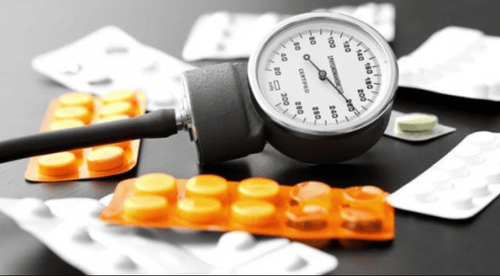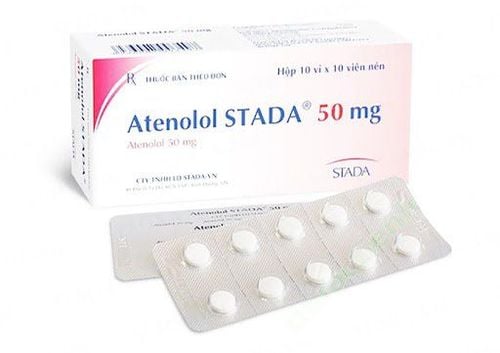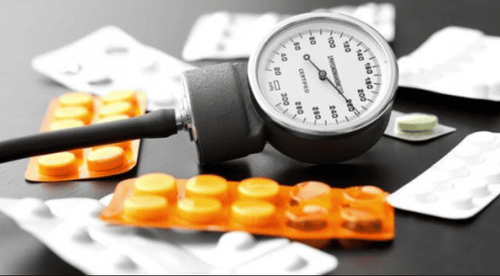This is an automatically translated article.
Angiotensin I to Angiotensin II converting enzyme inhibitors are widely used in the treatment of hypertension and heart failure. One of them is Enalapril with the brand name Zondoril 10. So what does Zondoril 10 mg do and how should it be used?
1. What is Zondoril 10 mg?
Zondoril 10 has the main active ingredient Enalapril maleate 10mg, produced by Ha Tay Pharmaceutical Joint Stock Company and circulated in Vietnam with registration number VD-21852-14. Zondoril 10 mg is prepared in the form of hard capsules, each box contains 10 blisters, each blister contains 10 tablets respectively.
2. What are the effects of Zondoril 10 mg?
The active ingredient Enalapril in Zondoril 10 belongs to the group of ACE inhibitors, acting on the renin-angiotensin-aldosterone system through inhibiting the conversion of Angiotensin I to Angiotensin II. The most important effects of Enalapril are vasodilation and reduction of peripheral arterial resistance.In heart failure, the active ingredient Enalapril maleate in Zondoril 10 has both the effect of reducing preload and afterload, improving cardiac output without significantly affecting heart rate. At the same time, long-term treatment with Enalapril can reduce left ventricular hypertrophy, reduce symptoms and severity of heart failure, and improve exercise capacity.
3. Indications and contraindications of Zondoril 10
Some subjects should use Zondoril 10 mg:
Patients with essential hypertension with both levels: Zondoril 10 can be used alone or in combination with other antihypertensive drugs. In low-renin hypertension, the effect of Enalapril is negligible. In contrast, with high renin blood pressure, the effectiveness of Zondoril 10 is greatly increased; Heart failure: Zondoril 10 offers some benefit and is therefore recommended for adjunctive therapy. Some subjects should not use Zondoril 10 mg:
People who are sensitive to Enalapril or other ACE inhibitors; History of angioedema due to ACE inhibitors; Elevated blood potassium levels.
4. Instructions for using Zondoril 10 mg
Patients need to carefully read the instructions for using Zondoril 10 included, do not arbitrarily use drugs by other routes not stated in the instruction sheet Zondoril 10 is prepared in the form of hard capsules for oral use.
The recommended dose of Zondoril 10 is as follows:
The recommended daily dose is 10-40mg (1-4 Zondoril 10 tablets), divided into 1-2 oral doses. The maximum dose is 80mg/day, however, it is advisable to start at a low dose because of the risk of excessive hypotension; Hypertension: Initial dose is 5mg/day (1⁄2 Zondoril 10 tablets), then adjust according to the response of blood pressure index. The maintenance dose of Zondoril 10 is determined after 2-4 weeks of dosing. If the patient has been treated with diuretics before, the diuretic should be stopped for 2-3 days before starting enalapril maleate. If not, the dose of Enalapril maleate can be reduced to 2.5mg (1⁄4 Zondoril 10 tablets) and monitored closely. This warning is issued because of the risk of excessive hypotension which can cause syncope, especially in patients with pre-existing ischemic or cerebrovascular disease; Heart failure: Zondoril 10 is often combined with digitalis and diuretics, so a reduction in the diuretic dose is required before starting Zondoril 10 and the patient must be monitored carefully. The initial dose in the treatment of heart failure is 2.5 mg (1⁄4 Zondoril 10 tablets), then gradually increased to the maintenance dose in each patient. Initial hypotension is not a contraindication to the use of Zondoril 10, but only requires appropriate dose adjustment thereafter; Patients with renal impairment should reduce the dose and increase the time between 2 doses of Zondoril 10 . In case of severe renal impairment (creatinine clearance less than 30ml/min or serum creatinine ≥3mg/dl), the starting dose is 2.5mg (1⁄4 Zondoril 10 tablets), the daily dose should not exceed 40mg. Although Enalapril maleate does not adversely affect renal function, the lowering of blood pressure due to Zondoril 10 may exacerbate existing renal failure; Patients on peritoneal dialysis can receive Zondoril 10 at the usual dose of 2.5 mg, but be aware that Enalapril maleate has the potential to cross the dialysis membrane.
5. Some cautions when taking Zondoril 10 mg
Before starting Zondoril 10, patients should be aware of the following:
Excessive hypotension with Zondoril 10 may occur in people who have used diuretics before, accompanied by hypovolemia. fluid accumulation (such as profuse sweating, vomiting, diarrhea, salt loss...) or heart failure and high renin blood pressure; When using Zondoril 10 in the treatment of heart failure, blood pressure values and renal function tests must be checked before and during treatment; Special care should be taken when using Zondoril 10 in patients with angioedema; When using Zondoril 10 for patients with bilateral renal artery stenosis, renal function should be carefully checked (due to the risk of increased plasma creatinine concentration); In the case of surgery requiring anesthesia with drugs that can cause hypotension, Enalapril will block compensatory renin release and secondary to the formation of angiotensin II. Therefore, if hypotension occurs, the most appropriate intervention is fluid resuscitation; Like other ACE inhibitors, Zondoril 10 can harm an unborn baby if used by a woman while she is pregnant; Enalapril is excreted in human milk, however the effect of Zondoril 10 on the nursing infant has not been studied.
6. Some side effects of Zondoril 10
The side effects of Zondoril 10 mg are usually mild and temporary, so most do not need to stop the drug. Some of the rare side effects that have occurred during treatment with Zondoril 10, including dizziness, headache, fatigue and weakness, occasional hypotension, postural hypotension, hypotensive syncope, nausea, diarrhea, cramps, cough, rash.
Some very rare side effects of Zondoril 10 , including onset of renal failure, oliguria.
Manifestation of angioedema due to Zondoril 10 may occur in the form of edema of the face, lips, tongue, pharynx, pharynx and extremities. In these cases, Zondoril 10 should be discontinued and supportive treatment given immediately.
Zondoril 10 may change the results of some laboratory tests such as increased liver enzymes, increased serum bilirubin levels, hyperkalemia, hyponatremia, increased creatinine and blood urea (reversible), decreased hemoglobin and hematocrit values.
Some other side effects of Zondoril 10:
Cardiovascular system: tachycardia, palpitations, arrhythmias, angina, myocardial infarction, cerebral vascular injury due to strong hypotension; Respiratory system: Bronchitis, cough, bronchospasm, shortness of breath, pneumonia, hoarseness; Digestive system: dry mouth, decreased appetite, vomiting, diarrhea, constipation, pancreatitis, intestinal obstruction; Liver failure, hepatitis, jaundice; Nervous system: Depression, confusion, insomnia; Thrombocytopenia, neutropenia, myelosuppression, rarely agranulocytosis; Proteinuria; Blurred vision, balance disorder; Tinnitus; Impotent; Change in taste, glossitis; Sweating.
7. Drug interactions of Zondoril 10 mg
It is not recommended to combine Zondoril 10 with the following drugs:
Potassium-sparing diuretics such as Spironolactone, Triamterene, Amiloride because blood potassium levels may increase, especially in people with renal failure. Therefore, when combining, it is necessary to check blood potassium levels regularly; Some data suggest that NSAIDs reduce the effect of Zondoril 10 . Some combinations that should be used with caution are:
Zondoril 10 in combination with other antihypertensive drugs should be noted due to increased potency, especially Thiazide diuretics; Lithium: Lithium clearance may be reduced with concomitant administration of Zondoril 10, therefore plasma Lithium concentration should be checked more frequently; Narcotic enhances the antihypertensive effect of Zondoril 10; Alcohol increases effect when combined with Zondoril 10.
8. Pharmacology and mechanism of action of Zondoril 10
After oral administration, Zondoril 10 is rapidly hydrolysed to the active metabolite Enalaprilate in the liver.
Pharmacokinetics:
The absorption of Zondoril 10 is not affected by food, a single dose is enough to maintain the effect for a day in most cases; The maximum plasma concentration of Enalapril is reached 4 hours after oral administration; The half-life of Zondoril 10 is 11 hours, the drug is excreted by the kidneys; Abrupt discontinuation of Zondoril 10 may result in a sudden increase in blood pressure. Zondoril 10 has the main active ingredient Enalapril maleate 10mg. The drug is indicated for the treatment of hypertension and heart failure. To ensure the effectiveness of treatment and avoid side effects, patients need to take medicine according to prescription or consult a doctor, professional pharmacist.
Follow Vinmec International General Hospital website to get more health, nutrition and beauty information to protect the health of yourself and your loved ones in your family.
Please dial HOTLINE for more information or register for an appointment HERE. Download MyVinmec app to make appointments faster and to manage your bookings easily.













